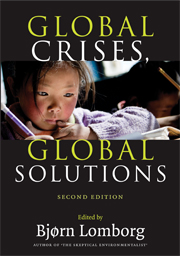Book contents
- Frontmatter
- Contents
- List of figures
- List of tables
- List of contributors
- Acknowledgements
- List of abbreviations and acronyms
- Introduction
- PART I THE CHALLENGES
- 1 Air pollution
- 2 The security challenge in conflict-prone countries
- 3 Disease control
- 4 The benefits and costs of alternative strategies to improve educational outcomes
- 5 Climate change
- 6 Hunger and malnutrition
- 7 Water and sanitation
- 8 The challenge of reducing international trade and migration barriers
- 9 Transnational terrorism
- 10 Women and development
- PART II RANKING THE OPPORTUNITIES
- Conclusion
1 - Air pollution
Published online by Cambridge University Press: 05 June 2012
- Frontmatter
- Contents
- List of figures
- List of tables
- List of contributors
- Acknowledgements
- List of abbreviations and acronyms
- Introduction
- PART I THE CHALLENGES
- 1 Air pollution
- 2 The security challenge in conflict-prone countries
- 3 Disease control
- 4 The benefits and costs of alternative strategies to improve educational outcomes
- 5 Climate change
- 6 Hunger and malnutrition
- 7 Water and sanitation
- 8 The challenge of reducing international trade and migration barriers
- 9 Transnational terrorism
- 10 Women and development
- PART II RANKING THE OPPORTUNITIES
- Conclusion
Summary
Introduction
Air pollution in its broadest sense refers to suspended particulate matter (PM: dust, fumes, mist, and smoke), gaseous pollutants, and odors (Kjellstrom et al. 2006). To this may be added heavy metals, chemicals and hazardous substances. A large proportion of air pollution worldwide is due to human activity, from combustion of fuels for transportation and industry, electric power generation, resource extraction and processing industries, and domestic cooking and heating, among others. Air pollution has many impacts, most importantly affecting human and animal health, buildings and materials, crops, and visibility.
In addressing the multiple burdens of air pollution, its related causes, and possible solutions, a broad distinction is necessary between indoor and outdoor air pollution:
• Human-induced indoor air pollution is to a large extent caused by household solid fuel use (SFU) for cooking and heating, usually involving open fires or traditional stoves in conditions of low combustion efficiency and poor ventilation. Indoor air pollution also originates from other “modern” indoor air pollutants associated with industrialization, with a variety of suspected health effects such as sick-building syndrome. However, from a global burden of disease point of view, these modern indoor air pollutants are relatively minor; this study therefore focuses on air pollution from SFU. Due to the close proximity and low or zero cost of solid fuels such as biomass in most rural areas, indoor air pollution is more of an issue in rural than in urban areas, although in many urban areas coal and charcoal are common household energy sources.
- Type
- Chapter
- Information
- Global Crises, Global SolutionsCosts and Benefits, pp. 7 - 57Publisher: Cambridge University PressPrint publication year: 2009
- 2
- Cited by

